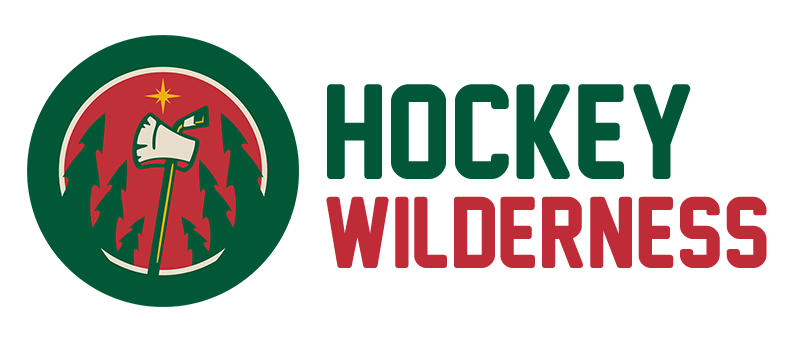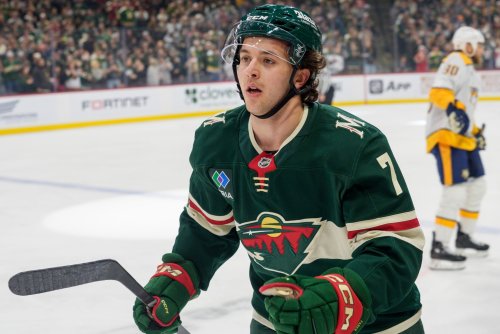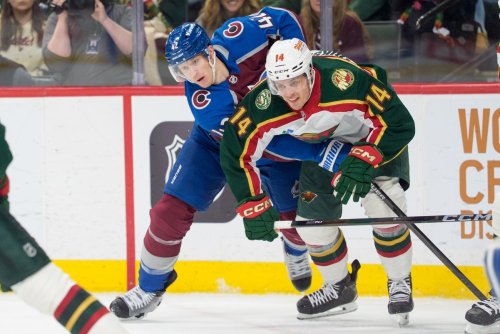.jpg.0516b55098647cc61a3dbc4646de3326.jpg)
In October of last year, Minnesota Wild owner Craig Leipold said he had asked Bill Guerin to develop a five-year plan to win the Stanley Cup. The Wild were still in the throes of cap hell, but they were a year away from relief.
Mr. Leipold wanted Guerin to show him Minnesota’s pathway out of first-round exits and into bona fide contention. The Wild fan base is passionate and hasn’t seen the team reach the second round since the 2014-15 season. They have been patient while the team navigates the Zach Parise and Ryan Suter buyouts, but expectations will change once they have the same cap space as every other team.
“We think about our fans all the time,” Mr. Leipold told The Athletic’s Joe Smith and Michael Russo. “We don’t want to overpromise and underdeliver.”
Mr. Leipold said there was “zero heat” on Guerin as he entered his sixth season as general manager, but there were five key elements of the plan:
- The team must re-sign superstar Kirill Kaprizov, who is eligible for an extension after this season. Nobody, Leipold says, will offer more money than the Wild, but it’s imperative that they convince him he can win in Minnesota.
- The team’s current core and rising stars, such as Matt Boldy and Brock Faber, must thrive.
- The team’s top prospects, like Jesper Wallstedt and Danila Yurov, must arrive and be impactful.
- And next summer, when the Wild have some cap space, they need to hit on a few difference-making free agents. It’s not a lot of space, but Leipold says they have already identified one or two players they want to sign, and that next July 1 will feel like “Christmas.”
Mr. Leipold and Guerin informed Smith and Russo that last season marked the second year of the plan. We’re still two years away from knowing whether it worked, but it looks like they’ve already overpromised and underdelivered.
Will Kaprizov re-sign?
Kaprizov probably isn’t going anywhere, but he will be expensive. Experts project the NHL’s salary cap to increase from $88 million to $113.5 million, meaning he may be worth $17 million per season. Kaprizov is in the final year of a five-year contract that pays him $9 million annually.
The Wild will gladly pay him what he’s worth.
“Am I convinced that we can (persuade him to stay)? No,” Leipold said last year. “Am I convinced that we will have a better offer than anybody else can do in the league? The answer is yes.
“I told you that this five-year plan is not a straight line. He’s the most important piece of our five-year plan. I think I can say that.”
Kaprizov is in blank-check territory, given what he means to the franchise. The Wild let Marian Gaborik, their only other superstar, walk for free after he turned down an eight-year, $80 million extension and got hurt the following season. Minnesota can’t afford to allow Kaprizov to do the same.
Still, with money comes pressure. At $17 million annually, Kaprizov would go from making less than Darnell Nurse and Seth Jones to making more than Auston Matthews, Nathan MacKinnon, and Connor McDavid. That’s a product of when Kaprizov will sign his extension. Still, people will hold him to a different standard.
The Wild would also likely extend him through age 35 because he entered the league at age 23. That shouldn’t be a major concern, given Parise and Suter would have played out their 13-year contracts had Guerin not bought them out.
Great players tend to be productive into their 30s. Still, Kaprizov’s mounting injuries are concerning. He played in only 41 games last year, yet still managed to produce 56 points.
The Wild will offer Kaprizov the largest contract. Their only concern is whether Kaprizov believes he can win here, and if another team closer to winning makes a competitive offer. Still, few contending teams have ample cap room, even with the rising cap.
Minnesota’s bigger issue is that while Mr. Leipold has bought into Guerin’s plan, Kaprizov may not. Most owners have confirmation bias when it comes to their general managers, unless their GM gives them reason to believe they’re mismanaging the team, because the owner hired them.
Meanwhile, Kaprizov will compare Guerin’s plan to the plans other teams present to him.
Can the Wild build a thriving core around Kaprizov?
Here’s where things get tricky. Next season will be Year 3 of Guerin’s plan, meaning Mr. Leipold will want to win the Stanley Cup by 2027-28, maybe 2028-29 if he feels the Wild are close.
To win a title, Minnesota will need a productive top-six, two reliable defensive pairs, and two goalies they can ride throughout the year. Because we’re looking two to three years into the future, we’ll examine their young core. Therefore, I won’t include players well into their 30s, like Jared Spurgeon, Mats Zuccarello, and Marcus Foligno.
Top six forwards
First line: Kirill Kaprizov, Joel Eriksson Ek, and Danila Yurov
Second line: Matt Boldy, Marco Rossi, and Liam Ohgren
Top four defensemen
First pair: Brock Faber and Jonas Brodin
Second pair: Zeev Buium and David Jiricek
Goaltenders
Jesper Wallstedt and Filip Gustavsson
I’m including Brodin but not Spurgeon here because Brodin, 31, will still be under contract in 2027-28. Spurgeon will not, and will be 37 when his contract ends in 2026-27. If you believe the Wild extend Spurgeon, and he’s a top-four defenseman at 38, pencil him in.
Regardless, the Wild are deep on defense, assuming Buium and Jiricek pan out. That’s why Guerin recently said they’re set on defense at the end of the season.
Their forward situation is less clear, though.
I formulated this list assuming that many of Minnesota’s top prospects pan out, using Scott Wheeler’s rankings as a guide. The defensive pairings assume Brodin plays well into his 30s, and Buium and Jiricek pan out, which are hardly guarantees.
However, the forward group requires multiple assumptions to work out.
- Kaprizov must re-sign in Minnesota.
- Yurov and Ohgren become productive top-six forwards in the NHL.
- The Wild extends Rossi.
The Wild must re-sign Kaprizov to contend in the next three years. However, it feels more likely that they’ll retain Kaprizov than Rossi. Ultimately, that’s a good thing. Kaprizov is a franchise player, while Rossi is a complementary star.
However, Guerin seems like he’s out on Rossi.
If Rossi becomes the next Matt Dumba, a talented player who’s perpetually on the trade block, it complicates Minnesota’s plans. It’s turning a jigsaw puzzle into a Rube Goldberg machine. To assemble a viable top-six without overpaying for aging veterans, which the Wild are wont to do, they’ll have to operate on a separate set of assumptions.
- Yurov will immediately take over as a second-line center.
- Ohgren will become a top-six forward.
- And they’ll find another top-six forward to round out the group.
That’s not that far-fetched, but it operates on less likely outcomes. The Wild would be asking Yurov to adjust to living in the United States, which was challenging for Kaprizov and Marat Khusnutdinov while playing second-line center at the game’s highest level.
I’ve always felt the Wild should have extended Rossi. Then, they’d have the option to keep him long term or trade him if they prefer Yurov or Charlie Stramel, who’s further down the prospect list. Instead, they’re banking on Yurov transitioning or Stramel’s slow development process accelerating.
Have they developed their top prospects correctly?
I’ve never been a fan of how the Wild have handled Rossi. If they manage top prospects like Buium, Yurov, and Wallstedt in the way they did Rossi, Guerin’s plan won’t yield results. Kaprizov is Minnesota’s cornerstone player, and established stars like Boldy and Faber will drive winning. Still, the Wild need to develop a championship team around them.
As we’ve learned, there was no “Christmas morning.” Brock Nelson or Brock Boeser wasn’t going to save them.
The Wild have the league’s No. 2 farm system. They must maximize it to build a contender. They can’t rely on players like Nelson or Boeser taking a hometown discount to join a team stuck in the league’s middle class. Instead, they must build a foundation of developmental success stories like Faber to elevate the team.
Tanking likely wasn’t an option because Mr. Leipold didn’t want to, and Guerin has bought himself time by keeping the Wild in the postseason. “If we’re almost there, maybe it takes us a sixth year,” Leipold said last October. “I’m OK with that. … But we have to start with a plan and feel good about where we’re going. We have to get out of this. I don’t like not making the playoffs. It’s embarrassing.”
To build a championship roster without bottoming out, Guerin had to rely on director of amateur scouting Judd Brackett to grab players who fell in the draft. That’s a viable strategy, but it requires that Guerin is satisfied with fallers, who have a flaw that keeps them from being a top pick.
If Guerin wanted large, skilled players, he had to tank to take players higher in the draft. The Wild made a conscious choice not to do that, and they can’t rely on free agency to build a contender. Free agents are often inefficient acquisitions, and star players may choose to join a team that is closer to contending for a championship.
Whether Guerin drafted viable players during Minnesota’s cap-strapped years will be the difference between his five-year plan being a pathway to a championship or if he just bought himself more time on the job.
Think you could write a story like this? Hockey Wilderness wants you to develop your voice, find an audience, and we'll pay you to do it. Just fill out this form.
-
 1
1
-
 1
1







Recommended Comments
Join the conversation
You can post now and register later. If you have an account, sign in now to post with your account.
Note: Your post will require moderator approval before it will be visible.